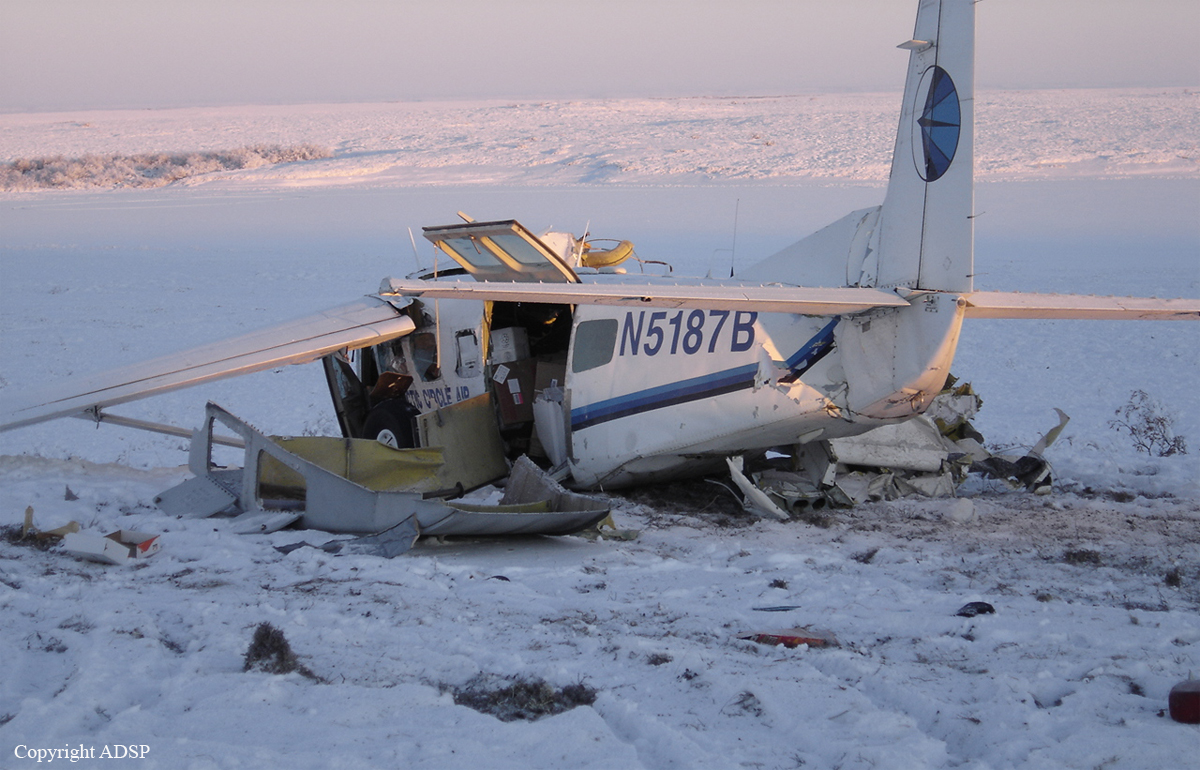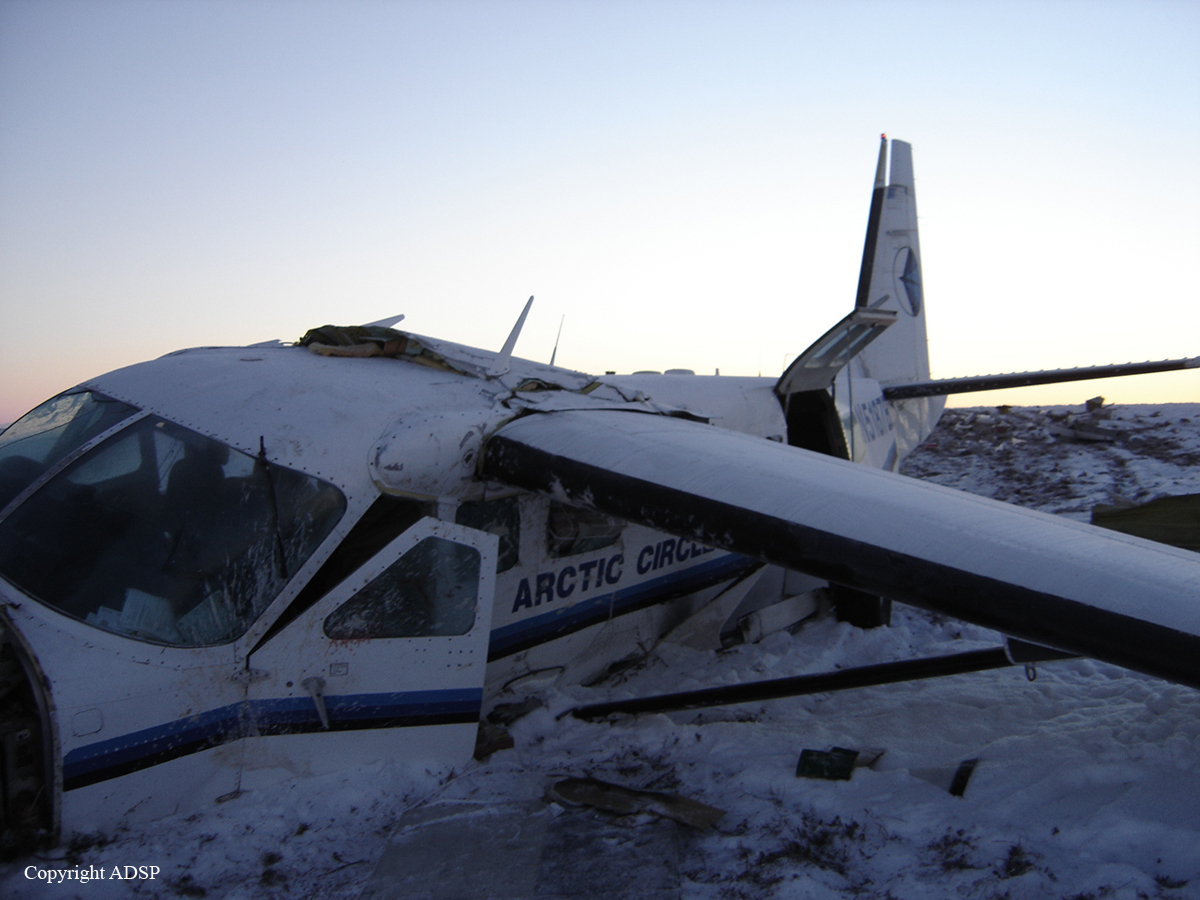Country
Operator Image
Crash of a Cessna 208B Grand Caravan in Bethel
Date & Time:
Dec 18, 2007 at 0856 LT
Registration:
N5187B
Survivors:
Yes
Schedule:
Bethel - Hooper Bay - Scammon Bay
MSN:
208B-0270
YOM:
1991
Flight number:
CIR218
Crew on board:
1
Crew fatalities:
Pax on board:
1
Pax fatalities:
Other fatalities:
Total fatalities:
0
Captain / Total hours on type:
190.00
Aircraft flight hours:
12204
Circumstances:
About 0800, the commercial pilot did a preflight inspection of the accident airplane, in preparation for a cargo flight. Dark night, visual meteorological conditions prevailed. He indicated that the weather conditions were clear and cold, and frost was on the airplane. He said the frost was not bonded to the skin of the airplane, and he was able to use a broom to clean off the frost, resulting in a clean wing and tail surface. He reported that no deicing fluid was applied. After takeoff, he retracted the flaps to about 5 degrees at 110 knots of airspeed. The airplane then rolled to the right about three times in a manner he described as a wave, or vortex-like movement. He applied left aileron and lowered the flaps to 20 degrees, but the roll to the right was more severe. The pilot said the engine power was "good." He then noticed that the airplane was descending toward the ground, so he attempted to put the flaps completely down. His next memory was being outside the airplane after it collided with the ground. The airplane's information manual contains several pages of limitations and warnings about departing with even small amounts of frost, ice, snow, or slush on the airplane, as it adversely affects the airplane's flight characteristics. The manufacturer requires a visual or tactile inspection of the wings, and horizontal stabilizer to ensure they are free of ice or frost if the outside air temperature is below 10 degrees C, (50 degrees F), and notes that a heated hangar or approved deicing fluids should be used to remove ice, snow and frost accumulations. The weather conditions included clear skies, and a temperature of -11 degrees F. Post accident examination of the airplane revealed no observed mechanical malfunction. An examination of the engine revealed internal over-temperature damage, and minor external fire damage consistent with a massive spike of fuel flow at the time of ground impact. Damage to the propeller blades was consistent with high power at the time of ground impact. The rolling/vortex motion of the airplane was consistent with airframe contamination due to frost.
Probable cause:
The pilot's failure to adequately remove frost contamination from the airplane, which resulted in a loss of control and subsequent collision with terrain during an emergency landing after takeoff.
Final Report:






Crash of a Short SC.7 Skyvan 3 Variant 100 in Mystic Lake Lodge: 1 killed
Date & Time:
Sep 20, 2007 at 1430 LT
Registration:
N2088Z
Survivors:
No
Schedule:
Mystic Lake Lodge - Anchorage
MSN:
SH1963
YOM:
1978
Crew on board:
1
Crew fatalities:
Pax on board:
0
Pax fatalities:
Other fatalities:
Total fatalities:
1
Captain / Total hours on type:
2600.00
Aircraft flight hours:
10730
Circumstances:
The airline transport pilot was departing in a twin engine turboprop airplane on a ferry flight from a remote lodge airstrip that was about 1,000 feet long and 40 feet wide. The airplane had previously received substantial damage to the nose wheel assembly on a previous flight to the airstrip. Repairs were made to the airframe, and the pilot was departing for a maintenance facility. The pilot had flown in and out of the airstrip on numerous occasions, but not in the accident type airplane. The lodge owner reported that the pilot started both engines and taxied the length of the airstrip, stopping momentarily several times. The pilot ran the engines for about 20 minutes, and then began a takeoff to the south. The airplane appeared to accelerate and remain on the centerline of the airstrip, but did not liftoff until the very end of the airstrip. The owner did not notice any unusual sounds or appearance of the engines. After liftoff, the wheels of the airplane struck and broke off the tops of trees and shrubs, that were about 6 to 7 feet above the ground. The airplane immediately veered to the right, and went out of the lodge owner's sight, but he continued to hear the airplane hitting trees until final impact. The airplane crashed in a shallow lake, coming to rest about 300 feet from shore, in about 5 feet of water. The entire cockpit area, forward of the wings, was torn off the airframe. The validity of any postaccident cockpit and instrument findings was unreliable due to the extensive damage to the cockpit. Likewise, structural damage to the airframe precluded determining wing flap settings during takeoff. Performance calculations indicated that the airplane's takeoff distance would have been about 950 feet, although the lodge owner said that in his experience, the accident airplane was capable of lifting off about half way down the airstrip without difficulty. The circumstances of the takeoff indicated that the left engine had been producing sufficient power to chop through several trees during the crash. Testing and inspection of the right engine was inconclusive, and although it was run on a test stand at reduced power, full power could not be attained due to ingestion of foreign material during the test run.
Probable cause:
A collision with trees during takeoff-initial climb for an undetermined reason.
Final Report:

Crash of a Short SC.7 Skyvan 3 Variant 100 in Nunapitchuk: 1 killed
Date & Time:
Mar 25, 1997 at 1123 LT
Registration:
N451SA
Survivors:
No
Schedule:
Nunapitchuk - Bethel
MSN:
1972
YOM:
1980
Crew on board:
1
Crew fatalities:
Pax on board:
0
Pax fatalities:
Other fatalities:
Total fatalities:
1
Captain / Total hours on type:
130.00
Aircraft flight hours:
7473
Circumstances:
The pilot of Cessna 207A, N800GA, was returning to his company base, passing about 2 miles north of a remote airstrip that was along the route of flight. The airstrip did not have any control tower. [Communications around an uncontrolled airport are conducted on a common traffic advisory frequency (CTAF)]. The pilot of a Short SC7, N451SA, announced his departure from the same airstrip on the CTAF, and took off in a northerly direction. He then began a climbing right turn toward the same destination as the Cessna 207A was proceeding. The two airplanes collided in mid-air, about 1.49 nautical miles east-northeast of the airstrip, which was about 18.3 miles west of their destination. They were observed spiraling downward from about 800 ft above the ground. Both airplanes were found lying flat and upright on a frozen lake, entangled together at the accident site. The Cessna's burned wreckage was lying on top of (and positioned toward the aft third of) the burned wreckage of the Short SC7.
Probable cause:
inadequate visual look-out by the pilots of both airplanes, which resulted in their failure to see-and-avoid each other's airplanes.
Final Report:
Crash of a Short SC.7 Skyvan 3A Variant 200 in Bethel: 1 killed
Date & Time:
Jul 13, 1992 at 1230 LT
Registration:
N20086
Survivors:
No
Schedule:
Bethel - Chevak
MSN:
1918
YOM:
1973
Crew on board:
1
Crew fatalities:
Pax on board:
0
Pax fatalities:
Other fatalities:
Total fatalities:
1
Captain / Total hours on type:
2000.00
Aircraft flight hours:
6390
Circumstances:
The airplane rolled 200-300 feet before becoming airborne in a very nose high attitude. It maintained this attitude, made a right, then a left bank, and fell to the ground in a nose high attitude. The cargo consisted of eight 55-gallons drums of fuel, laid on their side and secured by one cargo strap running fore and aft and another cargo strap running diagonally across the barrels. The tie down ring ultimate strength rating was 1,600 pounds. The weight of the cargo was 2,863 pounds. Three of the cargo hooks associated with the cargo straps were found still attached to the tie down rings, and one hook and tie down ring were not located. Post-impact fire destroyed the cargo straps, and the barrels were strewn randomly through the cabin/cargo area. According to the manufacturer, the davis tie down ring installation is not approved by the manufacturer. The modification should have been accomplished under a supplemental type certificate. The logbooks showed only an entry. The certificated max gross weight was calculated to have been exceeded by 324.8 lbs. The pilot, sole on board, was killed.
Probable cause:
Inadequate security of the cargo which shifted rearward during the takeoff roll. Factors which contributed to the accident were: the over gross weight condition, and the improper alteration of the tie down rings by the overhauling maintenance facility.
Final Report:

